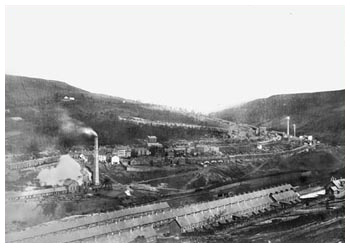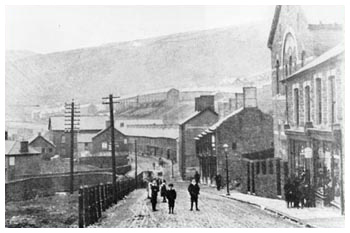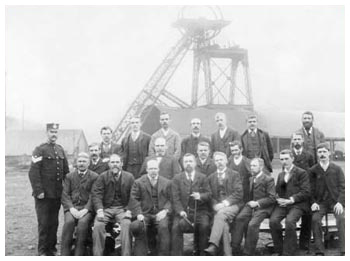
Tylorstown |
|
Tylorstown is named after Alfred Tylor a Londoner who purchased the mineral rights of Pendyrus farm in 1872 and sunk the first colliery in the village, also called Pendyrus. In common with the majority of the valley at that time the 1847 tithe map shows only scattered farmhouses, meadows, fields and vast tracks of Oak woods. As stated the beginnings of mining in Tylorstown, and hence the beginnings of the village of Tylorstown itself date back to 1872. It was at this date that Alfred Tylor of Newgate Street, London purchased the mineral rights of Pendyrus Farm and began the second large colliery concern in the Rhondda Fach. However great difficulties were encountered in the sinking of this first pit and thus it was not until 1876 that the steam coal seams were reached, at a depth of 333 yards. The first steam coal was despatched via the Taff Vale Railway to Cardiff in 1877 and from then on the development of Pendyrys Colliery (as it was then known was extremely rapid, going from 3,252 tons in 1877 to 241,061 tons in 1893. David Davis and Sons Ltd. eventually purchased the Pendyrys Colliery in 1894. |
Tylorstown circa 1900 |
Llewellyn Street Circa 1900 |
In common with many of the villages of the Rhondda the sudden influx of workers led to overcrowding, and poor housing conditions, with the first workers at Pendyrys Colliery housed in crudely constructed wooden huts. Initially only the bare minimum of community facilities were provided and as E.D. Lewis describes in his work, ‘The Rhondda Valleys, ‘…in many of these hastily erected townships of the Rhondda in the early days of the ‘coal rush', life bore a strong resemblance to the frontier townships of the United States.' The extent to which the workers of Tylorstown were tied to the local colliery is shown by the fact that in the early days even the water supply to houses in Tylorstown was entrusted to Tylor and Co. Tylorstown also had it share of tragedy when in 1896 an explosion killed 57 miners. |
The rate of development of Tylorstown is best illustrated by contrasting this image of a ‘frontier town' of the 1870's with the description given of the town less than thirty years later in the 1906 Kelly's Industrial Directory. |
Cynllwyn-Du Colliery Officials |
THE TYLORSTOWN COLLIERY EXPLOSION MONDAY 27TH JANUARY 1896 |
|
| The Rhondda Chronicle newspaper of the time describes how,' After only a few years immunity from the devastation of colliery explosions, the Rhondda has once more become the centre of very sorrowful and melancholy interest'. It goes on to describe how, ‘the Angel of Death had been at his dread task mowing down the colliers who were finishing their nights work in the Tylorstown colliery'. The report also details the thousands of people from Merthyr, Aberdare and Rhondda Valleys who congregated at the pit-head to wait anxiously for news of those ‘ entombed in the dark depths of the mine'. The newspaper also describes the ‘considerable' number of funerals and the large attendances accompanying them, both in the burial grounds of the district ( Llethrddu Cemetery, Maerdy Cemetery and Llanwonno Churchyard) and also those bodies taken away by train for burial in Aberystwyth, St.Clears, Cheltenham and Welshpool. The explosion at Tylorstown took place at approximately 5.30 am, a time when most of the night shift had ascended to the surface at the end of their shift and before the day shift descended into the mine. Thus the eventual death toll of 57 would have been much greater if the explosion had taken place at a time when a full shift, which consisted of over 300 men, was working below ground. An inquest into the explosion took place between the 18th and 25th February and the jury returned the verdict, ‘…the cause of the explosion was the firing of a shot in gas in Daniel William's stall in No.8 pit and that the air passing through the faces was charged with gas….and the explosion was accelerated by coal dust. Also that no one now living was responsible for the explosion'. Additionally Robert Woodfall and J.T. Robson, Inspector of Mines for the South Wales district wrote a Report into the explosion. They described the mine, owned by D. Davies and Sons Ltd. part of the Ferndale Coal Company, as dry and dusty and criticised the effectiveness of the watering of the mine. The mine was also describes as ‘fiery' necessitating a locked lamps policy with no naked flames except at lamp stations, and no shot firing being allowed during a shift. There was frequent presence of gas in the mines, however no standing gas was left to accumulate. In fact gas had been detected and dispersed from Daniel William's stall, where the explosion of the 27th January was thought to have originated, as recently as the 10th January. The Inspectors in their report concluded that the cause of the explosion was the fault of a fireman who had fired a shot in Daniel William's stall negligently, as he should have been aware of the presence of gas in the stall and immediate vicinity. |
|


